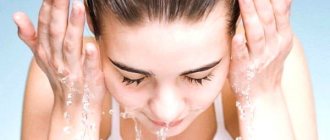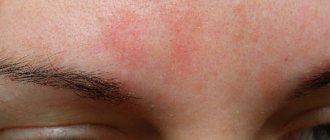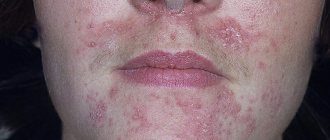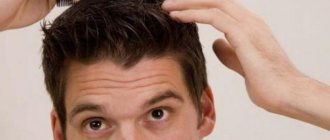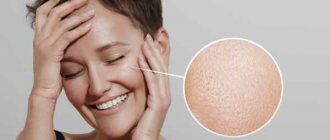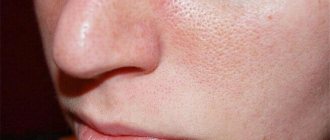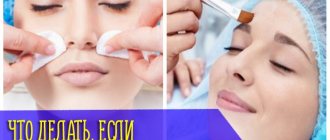INDICATIONS FOR THE PROCEDURE
Hormonal imbalance, unfavorable genetics, active puberty, improper care, constant exposure to aggressive external factors, some internal diseases - all this negatively affects the condition of the skin, leading to the appearance of enlarged pores, age spots, and rashes. Indications for the use of chemical peeling are the following conditions:
- wide pores;
- acne, comedones;
- sallow complexion;
- uneven terrain;
- stagnation, post-acne;
- pigmentation;
- age-related changes.
Why do pores expand?
To understand the cause of clogged pores, you need to have an understanding of their structure and functioning. Pore is a microscopic channel associated with the sweat and sebaceous glands, starting from the hair follicle located at the surface of the skin. Sebum is released from the pores, and hairs of varying lengths and thicknesses emerge from them (some cannot be seen with the naked eye).
This is an external excretory organ that participates in heat exchange, provides respiration, maintains the elasticity and moisture of the skin, and prevents it from drying out and the early manifestations of aging. In order for pores to perform their task well, they need to be cleaned regularly.
Expert opinion
Elena Apostolyuk
Cosmetologist
The tubules expand not without a reason, but as a result of the accumulation of dirt and fat particles in them. Cosmetic preparations provide only a temporary cleansing effect. In order to permanently normalize the condition of the skin, you need to find out and eliminate (or at least weaken) the factor that provokes the enlargement of pores.
Such a factor could be:
- Oily skin type. In this case, the pores are always filled with a dense fatty mass. The skin produces so much sebaceous secretion that it does not have time to get rid of it. To the accumulated fat are added keratinized skin cells, dust and dirt particles. The result is the appearance of comedones and acne. If these formations are not dealt with, then the fat-mud mass in the pores is affected by pathogenic microorganisms, and ulcers and boils appear in place of the blackheads.
- Age-related changes. Aging skin gradually plumps and sags, causing the pores to stretch and their openings to become more noticeable. In this case, using peeling is useless: the condition of the skin will improve, but the oval of the face will not be tightened.
- Excessive use of decorative cosmetics. Thickly applied foundations, powders and other means of masking defects clog the skin canals. The situation is aggravated by women themselves: they do not wash off makeup thoroughly enough, or even go to bed without washing their face, or use low-quality and expired products.
- Improper care for oily skin, use of inappropriate creams and cleansers.
- Addiction to cigarettes and alcoholic beverages.
- Incorrect diet, replete with fatty and fried foods, marinades, baked goods, and sweets. The body gets rid of excess fats and carbohydrates from food in various ways, including through the skin.
- Hormonal disorders associated with endocrine pathologies, puberty, pregnancy, menopause. The T-zone usually suffers: forehead, nose, chin. But in adolescence, expansion of the skin canals on the cheeks is also possible. Moreover, if the skin is oily, then this problem can remain for life.
- Pathologies of metabolism and digestive system.
- Frequent exposure to the sun, visiting solariums and beaches. Under the influence of ultraviolet radiation, the skin ages faster, collagen synthesis is disrupted, the sebaceous glands begin to work with excessive activity, which inevitably leads to blockage of the ducts.
DRUGS
The clinic's doctors use chemical peels with different compositions. TCA (trichloroacetic acid), PRXT-33, almond, and milk peels are effective against enlarged pores. The procedure eliminates dead cells, launches active regeneration processes, peelings are well tolerated even by sensitive skin.
Glycol formulations help with enlarged pores. They exfoliate, smooth, tighten, and improve the overall appearance. Enzyme peels are superficial; they cleanse the skin well and make pores less noticeable. The enzymes in their composition draw out all the contents from the pores and have a leveling effect.
Medium peels
This type includes peelings that work in the deeper layers of the dermis and, in addition to cleansing the skin, solve more serious problems - combating age-related changes, treating pigmentation, etc.
Salicylic peeling
This peeling is primarily used to combat inflammation and acne. The effectiveness of salicylic peeling is due to the unique ability of salicylic acid to penetrate the openings of the sebaceous glands and normalize their functioning.
This peeling is aimed at:
- Skin cleansing
- Elimination of rashes and inflammations
- Destruction of bacteria
- Normalization of the sebaceous glands
- Disinfection
Salicylic peeling is recommended for problematic and oily skin.
TCA
A fairly popular peeling based on trichloroacetic acid. The depth of peeling action is determined by the concentration of the acid and can vary from superficial to deep.
TCA peeling works in many areas:
- Deep cleansing
- Restoring skin tone
- Smoothing out wrinkles
- Lightening pigmentation
- Tone equalization
- Anti-inflammatory effect
- Stimulation of metabolic processes
- Increasing the barrier function of the dermis
TCA peeling is used for absolutely all skin types.
Jessner Peel
Peeling, which combines the action of two acids (lactic and salicylic) and resorcinol, which enhances the effect. Peeling has a strong antibacterial and antiseptic effect.
Indications for Jessner peeling are:
- Noticeable signs of skin aging
- Enlarged pores
- Acne
- Acne and post-acne
- Dry and dull skin
- Pigmentation
- Disruption of the sebaceous glands
Peeling can be used at any age and for any skin type, because... The depth of its action is determined by the number of peeling layers applied.
WHAT TO COMBINE THE PROCEDURE WITH?
Chemical peeling causes renewal of the epidermis and triggers active regeneration at the cellular level. The procedure has one disadvantage - it can have an aggressive effect on the skin. To improve the results of treatment and rejuvenation, pay attention to proper care - you may have to change the standard program. At the clinic you can buy professional cosmetics for active restoration, nutrition, and moisturizing of the skin. It increases the effectiveness of salon procedures and allows you to consolidate the results.
You can also combine peelings with contouring, Botox, thread lifting - if there are pronounced age-related changes. Mesotherapy and biorevitalization will saturate the cells with moisture, vitamins and improve the overall condition of the skin, solving the problem of hydration deficiency.
Deep peeling
This peeling works in all layers of the skin, starting from the superficial (removing it) and ending with the deep ones (regeneration processes are launched).
Yellow peeling
The basis of yellow peeling is retinoic acid, which can cope with complex problems such as scars on the skin. The peeling also contains other acids (kojic, phytic, azelaic) and vitamin C, which enhance the peeling effect.
Yellow peeling is aimed at:
- Skin cleansing
- Seboregulation
- Lightening pigmentation
- Removal of scars and stretch marks
- Elimination of acne and post-acne
- Smoothing out wrinkles
- Slowing down skin aging processes
- Increased skin tone
Yellow peeling is used for aging and problem skin, as well as for skin with severe pigmentation.
RESULTS OF THE PROCEDURE: BEFORE AND AFTER PHOTOS
Chemical peeling gives quick, pronounced results - to evaluate them, look at the photos before and after the procedure. The effect can be immediate or delayed over time - several weeks after completing the course, active regenerative processes will continue in the epidermis. Redness and swelling occur only after deep peelings - superficial peels refresh the skin and do not impose restrictions on lifestyle; if slight redness appears, it will go away on its own after a couple of hours.
Home remedies for tightening pores
Salons offer a wide range of intensive pore cleaning methods, but effective peeling can also be done at home.
But the result will not be quick; several procedures will be required. It usually takes up to 2 months to restore a person’s attractive appearance. The most popular home recipes that tighten pores, giving the face a healthy and well-groomed appearance:
- If you ask what the simplest and most popular homemade facial peeling recipe is, many women will answer - soda. A tablespoon of baking soda is diluted with water to a mushy consistency. Add a drop of lavender oil (or tea tree). The product is applied to the face and rubbed in with massage movements for 5 minutes. Wash off with warm water and use vitamin cream.
- Take 3 teaspoons of oatmeal and chopped lemon zest, 1 egg white, 15 ml of squeezed lemon juice. The ingredients are mixed and applied to the face. After 20 minutes, wash off with warm water.
- Take 2 teaspoons of potato starch, 3 ripe strawberries, 1 egg white, 10 ml of olive oil. Mix the ingredients, apply to the face, rub in with massage movements, hold for 20 minutes, rinse with warm water.
All-season peeling.
These are peels that can be used at any time of the year without fear of hyperpigmentation.
Peeling Kemikum
The main feature of this peeling is the presence of ozonides, which release oxygen and neutralize the effects of acids. As a result, the skin is actively saturated with oxygen, the production of collagen and elastin is activated, resulting in a noticeable lifting effect.
Indications for using Kemikum peeling include:
- Pigmentation and hyperpigmentation
- Dry skin
- Unhealthy facial tone
- Wrinkles
- Acne and post-acne of any complexity
- Scars
- Stretch marks on the skin
Peeling is indicated for all ages and skin types, because, despite the deep impact, the peeling effect is very soft and gentle.
Peeling PRX T33
This is the most popular peeling today! Positive reviews do not stop appearing and all this is for a reason!
Its incredible effect is due to three main components: trichloroacetic acid, kojic acid and hydrogen peroxide.
As a result of PRX peeling you will receive:
- Deep cleansing of the skin at all levels
- Activation of collagen and elastin production
- Antibacterial action
- Lightening pigmentation
- Evens out skin tone and texture
- Eliminate signs of skin aging
- Saturation of cells with oxygen
- Lightening pigmentation
- Removing acne marks
- Fighting inflammation and rashes
- Launching regenerative functions
Peeling is suitable for all skin types and even sensitive ones. The main task of peeling is deep but gentle cleansing and healing of dermal cells at all levels.
Peeling ULTRACEUTICALS VitaPeel
The peeling of the Australian brand, known for its natural and super-healthy compositions, is based on lactic and salicylic acid, as well as highly concentrated vitamins A and C.
Ultraceuticals peeling solves a whole range of problems:
- Gently cleanses the upper layer of the dermis
- Eliminates signs of skin aging
- Improves skin tone and condition
- Lightens pigmentation
- Restores water balance
- Improves the protective functions of the dermis
Indications for peeling are problematic skin, the presence of hyperpigmentation and the first sign of skin breakdown.
Back to blog
Features of facial cleansing
Facial skin cleansing can be ultrasonic, vacuum, manual, and each method has its own characteristics and indications. Before the procedure, it is necessary to thoroughly clean the skin of cosmetics and impurities and steam and loosen the stratum corneum. Many cosmetologists use a special warming gel, which helps open clogged pores.
Facial cleansing is contraindicated for people with sensitive, thin and dry skin, dilated vascular walls, bronchial asthma, herpes, eczema and other infectious and allergic skin diseases. It is not recommended to carry out the procedure before or during menstruation, since during this period the skin is prone to allergic and inflammatory reactions.
After cleansing, the facial skin is treated with a special lotion. Then a professional cosmetologist begins to cleanse the pores, removing the thin film of fat covering the epidermis, dead cells and black comedones. In this case, special lighting is used to improve visibility.
In case of multiple comedones and pore contamination, the procedure can be carried out in only a few sessions. In advanced cases, facial cleansing is combined with darsonvalization and vacuum procedures.
At the final stage, the facial skin is disinfected with lotions and tonics, which help narrow pores and relieve redness. For these purposes, infrared radiation and clay-based cosmetic masks are also used. Healing clay has the ability to absorb excess sebum, relieve inflammation, cleanse and tighten enlarged pores. After the procedure, the skin of the face acquires a healthy color, and the pores become barely noticeable. But within a few days there is obvious hyperemia and peeling, and itching may occur.
Mechanical cleansing of the face if sterility is not maintained can lead to the development of an infectious process, inflammation, or the addition of a secondary infection, therefore such a cosmetic procedure should be carried out only in a specialized beauty salon or beauty salon.
It is forbidden to wash your face for 24 hours after the procedure. It is also not recommended to use alcohol-containing lotions and tonics for several weeks, or visit solariums and public beaches. The skin after such a traumatic procedure needs rest and protection. If crusts appear after mechanical cleaning, do not open or remove them under any circumstances, otherwise scars will appear in their place.
When is this procedure needed?
We recommend booking a salicylic peel in the following cases:
- You have very oily or breakout-prone skin, and regular products won't help.
- You are tormented by acne and its consequences.
- The skin has lost its former elasticity, become flabby, folds and wrinkles have formed.
- You want to get rid of freckles or age spots.
The best time for peeling is autumn and winter. There is very little sun during this period, and your skin will be in less danger than in summer. In addition, peeling will be an excellent prevention of unwanted pigmentation.
Types of peelings for facial skin
An experienced specialist will help you determine which type of facial peel to choose. The effect of the procedure depends on the depth of exposure of the drugs. The cosmetologist will assess the condition of the skin, the specifics of existing problems and recommend the most suitable option.
Name and description of the main types of facial peeling:
- Superficial peeling. The procedure involves cleaning only the upper layers of the epidermis, without affecting the living layers. The process of superficial peeling removes dead cells. There are practically no contraindications to this procedure, it is painless and does not cause complications.
- Medium peeling. Involves cleaning the entire skin layer. During the session, drugs penetrate deeper into the epidermis, which has a beneficial effect on metabolic processes. Medium peeling is performed only by a professional cosmetologist. After such manipulations, the skin needs intensive restoration.
This type of facial peeling in cosmetology is intended for rejuvenation. It helps eliminate large areas of pigmentation, reduce deep wrinkles, and get rid of old spots. After the procedure, minor burns and red marks remain, so the recovery period can be 3–4 days.
- Deep peeling. Quite a complicated procedure. All manipulations are performed only in a hospital setting with mandatory pain relief. In the process, all layers of the epidermis are destroyed. Tissues begin to regenerate from the remaining fragments.
Deep peeling (laser and chemical) is an aggressive cleaning method. This procedure immediately rejuvenates by 8–10 years, due to the almost complete burning of old skin and its replacement with new one.
The most common anti-aging procedure is medium peeling.
In order to refresh the skin, superficial cleaning is performed at least 2 times a month. To eliminate defects and prevent early age-related changes, medium peeling is performed twice a year.
Indications for deep peeling must be very serious.
There are the following types of peelings for cleansing the skin:
- chemical;
- mechanical;
- ultrasonic;
- laser.
Let's look at each type in more detail.

